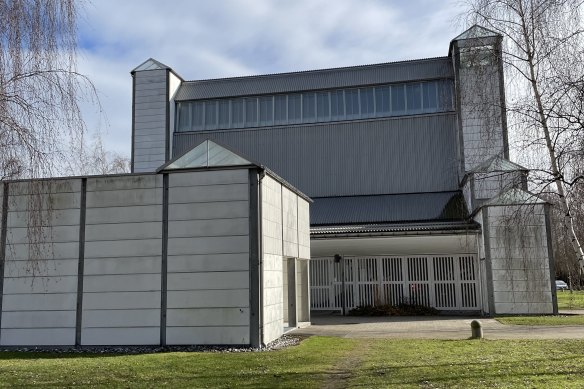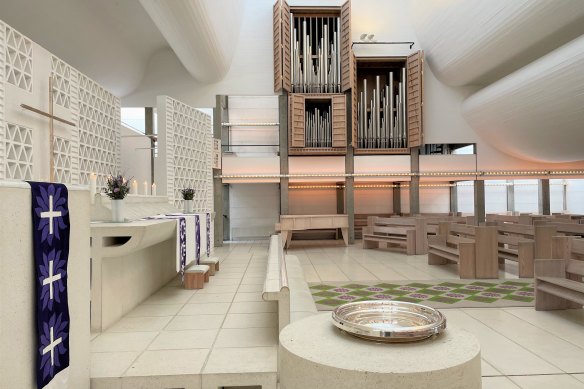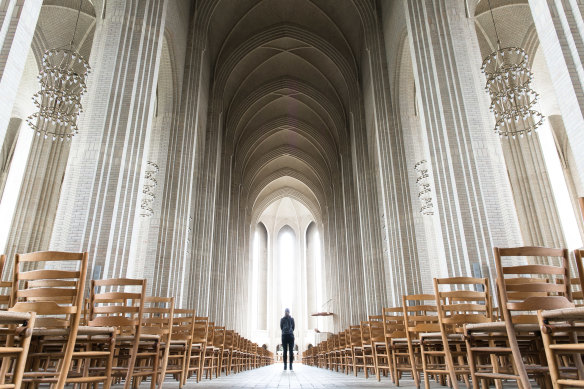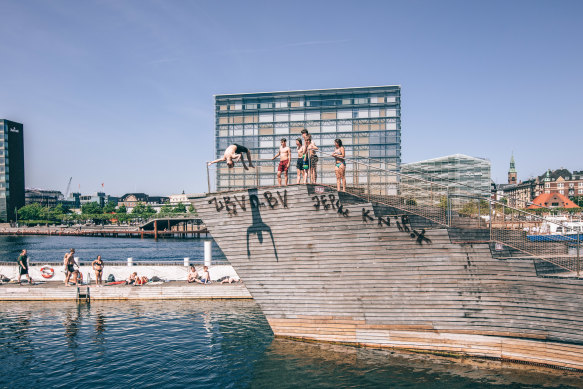Opera House architect’s Danish church is not what you’d expect
We almost miss Bagsvaerd Church. From the outside it doesn’t look much like a church at all… perhaps a fancy school, or an institution of a sort, but not a church. That said, many of Jorn Utzon’s architectural feats break from norms, so it’s no surprise that the exterior is so… well, rectangular.
The perimeter of the building is faced with large rectangular concrete panels and glazed tiles arranged shoulder to shoulder, a bit like a football team lined up ready to sing their anthem. The overall picture is very neat… uniform… solid… and nothing like the very angular Sydney Opera House.

Bagsvaerd Church. From the outside it doesn’t look much like a church at all.
The interior is another story – a bride who has just slipped into her pristine white dress. The enveloping white, along with the unfinished concrete and bleached pine, accentuates the sinuosity of the design, which is in sharp contrast to the straight-lined exterior.
The sun is shining outside today, and the curved vaulted ceilings funnel the daylight in, illuminating the dust motes dancing above the carpet of the central aisle. The carpet, altar cloth and textured masonry walls, designed by Utzon’s daughter, Lin Utzon, inject a little bit of colour into the space.
I’m not sure if we would have driven to Bagsvaerd Church had we not been familiar with Utzon’s work, but having visited Sydney’s Opera House a multitude of times, I was curious. My husband, on the other hand, simply enjoys visiting churches.

Inside Bagsvaerd Church.
While we still have our rental car we make another church stop – Grundtvig Church in the residential neighbourhood of Bispebjerg (also referred to as Nordvest). I’m rendered speechless as soon as I catch sight of the stunning edifice. The gothic cathedral is made from a single material – pale-yellow brick made of Danish clay – and it towers over the streetscape imposingly, as if it knows just how remarkable it is.
Architect Peder Vilhelm Jensen-Klint finished the initial design of the church in 1913, but construction work did not begin until 1921 due to heated discussions among community members about where to build it. Klint passed away before finishing his ambitious project, and his son – architect and designer Kaare Klint – took over. Kaare Klint also designed the chairs that are used in the church and are now considered a Danish furniture design classic.

The breathtaking Grundtvig Church.
Design is everywhere in Copenhagen. You could spend days exploring the city and ticking off a lengthy list of notable buildings and design pieces. Or you could spend a few hours simply meandering about while your cruise ship is docked.
Design is deeply ingrained in daily life, and Copenhagen was officially designated as the UNESCO-UIA World Capital of Architecture for 2023. A series of events on the theme “Sustainable Futures – Leave No One Behind” will run throughout the year, with visitors offered unique opportunities to learn, debate, watch and participate.
Camilla Van Deurs, Copenhagen’s Chief City Architect, explains that the UNESCO designation is thanks to Copenhagen’s strong legacy of architecture. “We have a rich design history. From King Christian IV of Denmark who erected many of the city’s historic buildings, to prominent, modernist Danish architects and designers such as Arne Jacobsen, Hans Wegner and Georg Jensen,” she says. “These pioneers have put Denmark on the world map of architecture, and their legacy has been carried on by innovative, contemporary Danish architects and designers such as Bjarke Ingels Group (BIG), Vilhelm Lauritzen Architects, Henning Larsen, HAY, to name a few.
World-class Danish architects like Jorn Utzon have designed places like the iconic Sydney Opera House, and Arne Jacobsen has designed the functionalist Bellavista housing complex north of Copenhagen.”
Although we don’t get to the Bellavista complex, we hire bikes and join the masses of fellow cyclists to experience how design is integrated into daily life. Copenhagen has been voted the world’s best city for cyclists several times (a whopping 42 percent of Copenhageners commute to work or study daily in the saddle), and we’re keen to join in.
We cycle to Enghaveparken first, carefully trying to avoid high bike traffic areas with a little human each perched behind us. First laid out in 1929 with some parts drawn up by Arne Jacobsen, the green space has recently undergone a revitalisation. Significant rainfall over the years – particularly high-intensity cloudbursts in 2011 – called for a redesign, and San Francisco-based landscape design studio Third Nature took on the job. The revamped park can now contain over 22 million litres of water in reservoirs, which have been elegantly integrated into its neoclassical design.
Water is everywhere. The Danes drink some of the cleanest water in the world, and Copenhagen is traversed by canals and encircled by water. It’s nippy today, but still there are swimmers powering through laps. Not us though. We cycle the 13 kilometre-long Harbor Ring route with its 11 bridge crossings, admiring the water from afar.

Copenhagen – a city of swimmers.
The loop tracks its way through some of the city’s newer urban districts with attention-grabbing architectural sights left, right and centre. We take it slow to appreciate the views (and stop for pastries… for the kids). The leisurely pace provides us with a glimpse into city life, and how seamlessly design is interwoven into it.
After a few days of exploring, I understand both why Copenhagen has been named World Capital of Architecture for 2023, and why its subtitle is “Copenhagen in Common”. It is an outstanding example of a city which combines architecture, history and everyday life to create a unique urban identity alongside a sustainable urban environment.
We manage to fit in a visit to the Danish Architecture Centre before flying out, and dive a little deeper into the role architecture and design play in urban design. The first permanent exhibition on Danish architecture opened on March 24 — as part of the city’s celebration of its designation as World Capital of Architecture for 2023 — but even so, the majority of the museum is dedicated to design, with some really thought-provoking exhibitions.
Yet, it’s not only the exhibitions that grab our attention, but the way in which the content is displayed. My eldest plays with blocks and giant chairs for an hour, assembling the pieces in a variety of configurations, while my youngest crawls around and into a tilted house on repeat. The fun continues even when we move on from Kids’ City to the main museum.
It’s immersive, yes, but it’s more than that. It’s all-encompassing. Completely absorbing. Our longer-than-anticipated visit ends with me sliding down a four-storey slide, which begins on the top floor and ends in the entry foyer. Designed by German-Belgian artist Carsten Holler, it’s functional art with a dose of fun injected in.
My eldest promises that she will follow, but chickens out and takes the stairs down with the rest of my clan. I usually encourage her to give new things a go, but this time I don’t bother. I know we will be back soon and she can try again then.
Tatyana Leonov travelled at her own expense and with some support from Visit Copenhagen. See visitcopenhagen.com
The details
Fly
Singapore Airlines operates over 110 flights per week from seven Australian cities to Singapore, with flights connecting onwards to Copenhagen five times per week. See singaporeair.com
Explore
There are a host of architecture and design events, activities and exhibitions throughout the year, with a focus on Copenhagen’s architectural heritage and the sustainable challenges ahead. See arkitekturhovedstad.kk.dk/en/program
Stay
For a unique stay on the design theme, The Audo is a collection of shared spaces – a concept store, café, restaurant, and 10 boutique Scandi-designed residencies located on the upper floor. See theaudo.com
Sign up for the Traveller Deals newsletter
Get exclusive travel deals delivered straight to your inbox. Sign up now.